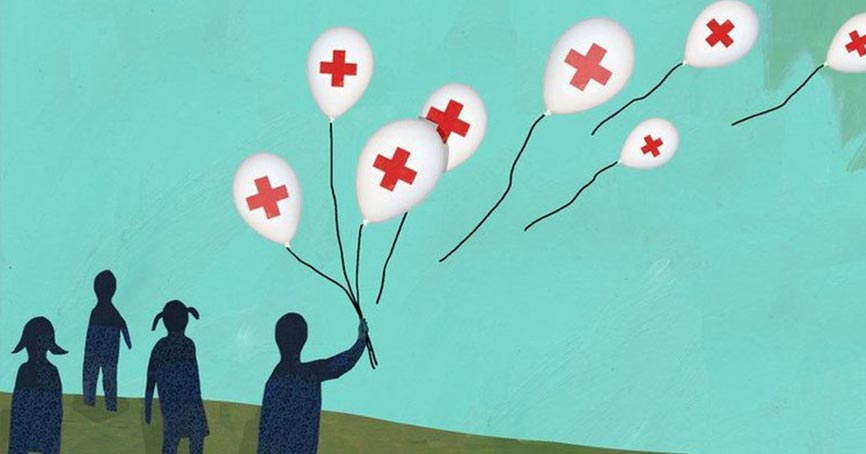A heart attack occurs when the blood flow to the heart is improper due to a clogged artery. This blockage prevents oxygen-rich blood from reaching to a section of the heart. If not reopened in time, the section of the heart not receiving the blood begins to die. Basically, a heart attack does a lot of damage to the heart muscle. To reverse damage after a heart attack, doctors have been researching since long and some of them even have an answer.
What really happens?
What happens during a heart attack? How much damage is caused? Is the damage permanent? There may be a number of questions that may come to one's mind about one of the most common heart ailments- HEART ATTACK.
The lack of blood supply to the heart muscle leads to myocardial cell death which results in scar formation. When the main artery gives blood flow to a large area of the heart muscle, the scar is usually larger. Depending on the extent of myocardial scarring, progressive left ventricular remodeling occurs. This is accompanied by enlargement of the left ventricle, development of congestive heart failure, loss of muscle function and in rare cases sudden death.
To relieve
myocardial ischemia, the occluded artery is reopened as early as possible to ensure minimum heart damage.
Reverse Damage After Heart Attack
One of the most common questions heart attack survivors ask is whether heart attack damage has chances of reversal.
The most common disease affecting people all over the world does have a chance to be reversed. In fact, a new case that has come to light is taking cells from a biopsy from the patient's own heart.
In this method, the cells are taken from the patient's own heart and multiplied in a laboratory for two to three weeks. After this, these cells are reinfused through a catheter. The stem cells themselves turn into a new heart muscle and blood vessels which strengthens the heart muscle.
However, besides these major changes in the heart and its structure, there are some other changes that we can follow ourselves. These involve exercises and diet control to strengthen the heart and bring it back to where it was.
Undo the Damage
There are a number of medications that one may take as a way of treatment. However, research has time and again shown how diet, exercise and stress management can reverse the damage.
Research by Dr. Ornish in the 1990s devised a year-long lifestyle modification program for patients with any cardiovascular disease. The trial emphasized the impact of moderate exercise, low-fat vegetarian diet, no smoking and stress management for a healthy heart.
The participants of the research made a few alterations to their diet and did not take any cholesterol-lowering medications. The results of the program were impressive as it showed some good statistics-
- 91 percent reduction in the number of chest pains
- 4.5 percent reduction in narrowing of coronary arteries after a year
- 7.9 percent improvement in the coronary arteries after five years.
On the contrary, the other patients who had a heart attack and received standard medical treatment were seen to have almost 28% increase in the narrowing of the arteries after five years. Moreover, this chunk of patient experienced double cardiac events like a heart attack.
Moreover, simple lifestyle changes can reverse event fatal diseases like type 2 diabetes, early prostate cancer and even change gene expression.
Undo It with Dr. Ornish Regime
This is a heart program by Dr. Ornish and is the first lifestyle regime that reverses the damage by any cardiovascular disease like a heart attack. It targets these 4 main areas-
- Changing what one eats for something healthier
- Increase in daily exercise
- decreasing stress
- improving support from friends and family
It involves 18 hour-long sessions within a designated group and the results have been extremely positive. It aims to reduce the need for medication in people with a high risk of heart disease and people who have been sufferers of the disease.
The plan involves eating foods as naturally as possible rather than in the processed form. One of the main elements here is that daily fat intake should not be more 10 percent.
Say yes to:
- Vegetables and Salads
- Fresh Fruits
- Up to two cups of green tea a day
- Healthy alternatives like water, herbal teas and grain-based coffee substitutions like barley.
- Nuts, seeds, avocado and plant oils like olive and rapeseed
- Legumes like chickpeas, dried/ canned beans
- Whole grains like barley, quinoa, whole grain pasta, bread, oats, and brown rice.
- Soy-rich foods like tofu, soybeans, and soymilk
Say a big NO to:
- Red meat
- Caffeine
- Transfat found in biscuits, pastries, and fast foods
- Full-fat dairy products
- Alcohol
- Refined carbohydrates found in cakes, processed cereals, crackers, white bread, white rice, and pasta
- Added sugars like those in cordials, soft drinks, and sweets

 Jun 04, 2019
Jun 04, 2019
 May 30, 2018
May 30, 2018 May 10, 2018
May 10, 2018 May 17, 2018
May 17, 2018